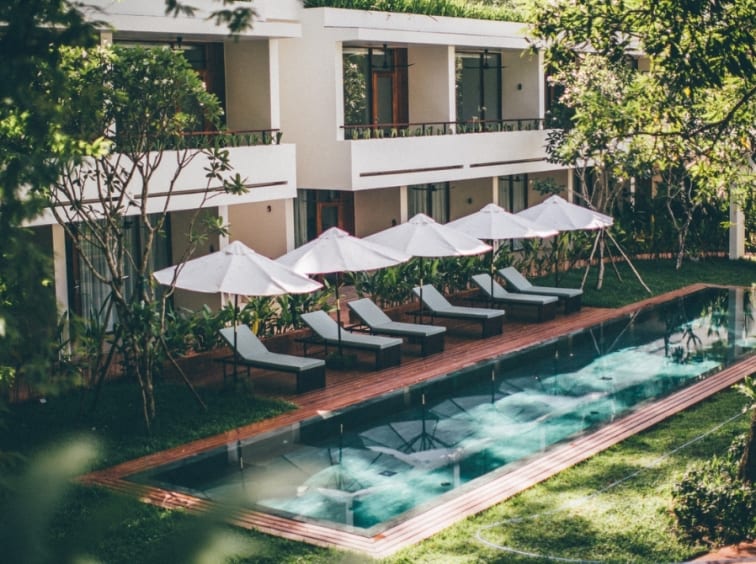Avani Travel Diary – FCC Angkor by Avani Photo Tour
Most travellers know Siem Reap as the gateway to the ruins of Angkor. But the proximity to a World Heritage site is both a blessing (as any hotel and restaurant owner will tell you) and a curse — hardly anyone is here for the town itself. Which is a shame, because Siem Reap is filled with history, culture, and architectural jewels that often go unnoticed.
Those who appreciate fine architectural design will find plenty to marvel at during a stay or a tour of Siem Reap’s FCC Angkor by Avani (the acronym stands for the Foreign Correspondent’s Club), which traces its history back to the colonial days.
.jpg)
The FCC started life as the Siem Reap French Quarter residence, before getting a revamp from the storied architect Gary Fell, known for a style that favours clean, geometric lines.
When it was time to bring new life to the historical property, Bangkok-based Malee Whitcraft was tapped, in conjunction with Bloom Architecture based out of Phnom Penh, to oversee the $7 million re-design. What FCC guests see today is the result of this inspired collaboration.
Post-refurbishment, the vibe is retro tropical modernist, with a strong sustainability ethos. And despite its very central location right next to the Royal Residence and a five-minute walk from the Old Market area, the FCC feels secluded and at one with nature.
The new sections of the building are clad in sandstone and the architects commissioned all the furniture to be made from natural materials that have been treated with eco-friendly products, to better stand up to the heat and humidity of the jungle setting.
.jpg)

.jpg)
Most of the public spaces are open to the elements, including the villa at the heart of the resort. Originally the French Governor’s residence, this Art Deco-style 1960s French Khmer beauty later welcomed foreign correspondents and journalists from around the globe.
Today it is home to The Mansion, the club’s airy restaurant that also features a gallery showcasing local artists in the newly added lobby. In fact, the property’s collaborations with local creatives started even before the hotel reopened — murals featuring Khmer proverbs in the rooms were hand-painted by a local artist.
.jpg)
.jpg)
.jpg)
.jpg)
.jpg)
Scribe Bar was added below the restaurant as a gathering place for hotel guests as well as locals, who come to sip zero-waste cocktails, craft beer, natural wine, and artisanal sake. It’s a great pre-dinner drink place where you can watch the traffic along Pokambor Avenue.
.jpg)
.jpg)
.jpg)
The rooms form a two-story horseshoe around the greenery-ringed swimming pool. There is also a black slate saltwater pool that sits under huge trees and is atmospherically lit at night. For the interiors, architects sought to work with local Khmer artisans, whenever possible.
.jpg)
.jpg)
.jpg)
Textiles, such as bed runners and chair cushions, were produced by women at local weaving villages and exhibit the kind of exquisite craftsmanship that makes the resort a treat for all the senses.
Guests with an eye for detail will also spot retro peacock chairs mixed with copper elements and tiles handmade by a local family that has been in business for 300 years.
In the rooms, rotary phones and antique typewriters collected at flea markets evoke the building’s history as a reporting hub.
.jpg)
With two sumptuous queen beds, the Family Suite features an inviting terrace shaded by a centuries-old banyan tree. The space is big enough to accommodate a separate dining area, a cosy sunning nook and a spa corner with a soaking bathtub.
Located on the ground floor and overlooking the lush courtyard, the Garden Suite opens onto a covered patio where rattan dining set invites to linger in dappled sunlight. Rattan chairs and wooden tree tables were handwoven by special order too. Everything was carefully selected to show the skills of the Khmer people.
The Riverview Suite is the resort’s largest. Located on the top floor of the new wing, it boasts a stunning terrace looking out onto the tranquil river and swaying treetops. The star piece is undoubtedly the outdoor sandstone bathtub carved by Khmer artisans.
As befits the resort that takes relaxation of its guests seriously, a spa was added during the final renovation phase. Its four airy treatment rooms are bathed in natural daylight and overlook a serene courtyard. Combining the elegance of soothing terracotta tones with subtle touches of copper, the décor reflects Visaya Spa's vision of simplicity.
(All images are courtesy of Dao and Tan of When We Wander travel blog.)




